如何回复审稿人意见
专家审稿意见回复范文如何回复中文审稿人意见结尾如何写

专家审稿意见回复范文如何回复中文审稿人意见结尾如何写第一,不论审稿人提了什么意见,你在回复的时候一定要说:谢谢您的建议,您的所有建议都非常的重要,它们对我的论文写作和科研工作都具有重要的指导意义!第二,如果审稿人提 ___你暂时无法做到(比如,要你增加实验或改进实验等)。
那么,为了论文尽快发表,你必须拒绝这样的要求。
但是,你不要摆出一大堆理由来证明这个意见是不好实现的。
你应该说:“谢谢您的建议,它非常的重要,由于您的建议,我发现了我目前工作中的不足之处,我会在以后的工作中按照您的建议提高科研水平,取得更多成绩!”这样说,等于委婉的拒绝了评审意见,又让评审人觉得你很看重他 ___。
第三,如果审稿人 ___明显有问题,也不说能说审稿人 ___是错误的,可以他 ___发表任何的评论,只需要列出你的理由和证据就可以了,结尾也不要强调自己的观点是正确的。
一句话,就是凭证据说话。
第四,如果审稿人的评价比较傲慢,而且有失公平。
那么,不用客气,直接写信给,痛批审稿人。
(我就遇到过这样的情况,痛批后反而被录用。
)第五,在回复信的结尾最好写上再次谢谢您的建议,希望能够从您哪里学到更多的知识。
这句话最好用黑体,要显眼。
保持正确的语调,做出回应。
说明(1)在回复审稿人意见的时候,除了写明修改内容外,还有一些话是必须要写的。
这个其实也可以归纳为礼貌用语,大家一般也都会注意到。
但是,有些时候还是容易“放飞自我”。
实验室的一位师兄,花了很长的时间搞出来一个很有idea的文章。
(2)在回复审稿意见的时候,前面还是客客气气的回复,一读到关于自己核心idea的时候,立马心态就炸了,言辞什么的就有点过激了,最后当然直接被拒了。
其实能作为审稿人,一般都是这个领域的专家或者有一定贡献的人,既然能指出你的问题,就说明还是存在不合理的地方,那就认认真真去修改就好了,千万不要太持才傲物。
(3)里很多人都会轻易犯错,尤其是刚发论文的时候,总觉得自己一定要根据审稿人的每一条意见都做出修改。
如何回复审稿人意见

接着上一篇交流贴,这一次我想给大家分享一下我回复审稿人的一些经验。
根据个人经验,我将审稿人划分成三类人。
我对每一类人的回复方式是有差别的。
第一类人是像我这样的博士生。
跟着导师做课题,已经发表了几篇文章,导师是通讯作者。
审稿邀请发给导师后,导师转发给学生审稿。
从我自身出发,这一类人的特点就是有一点傲气,有点急功近利,审稿同行文章是带有非理性感情的。
很惭愧,我审过几篇稿,意见中也是带有偏见的。
现在感觉非常幼稚,我非常想对那些人说声抱歉。
其实这也是一个成长过程,经历过就不会再犯同样的错误了。
言归正传,其实这种审稿人是比较容易对付的。
对于这种人你的使劲把他往天上捧,然后尽量用商量的语句对付那些不好或者不可能回答的问题。
我觉得,一定不能不回答,即使不能回答编故事也是可以的。
为什么可以编故事呢?因为这一类人(包括我)实际上只是半罐子水,而且不一定完全了解你的方向,懂的东西不一定比你多。
像这样的情况,你就得发挥自己专长,尽量用专业的术语和分析绕圈子。
最后加一句,we deeply appreciate the reviewer's comment and would very much like to consider this direction of research in our future work. 或者说,This is an essential part of research which is currently under active development. 这样,一般都能糊弄过去。
下面是我如何回复这样审稿意见几个例子:第一个是说contribution不够significantAuthors would like to express our most sincere gratitude to the reviewers for your effort and patience in reviewing our manuscript (MS). We deeply appreciate your constructive comments that greatly help improve the technical quality and the presentation of this manuscript. Please also accept our apologies for not being able to present clearly the real contributions of the work. ( 先使劲捧他)然后再清楚的解释你的real contribution 。
【共享】如何回复SCI投稿审稿人意见

【共享】如何回复SCI投稿审稿人意见1.所有问题必须逐条回答。
2.尽量满足意见中需要补充的实验。
3.满足不了的也不要回避,说明不能做的合理理由。
4.审稿人推荐的文献一定要引用,并讨论透彻。
以下是本人对审稿人意见的回复一例,仅供参考。
Correspondence.doc (30.5k)chenchenx老师,谈的比较具体,很有针对性,具有普遍意义。
希望战友们各舒己见,谈谈如何回复SCI投稿审稿人意见。
加分从优!!chenchenx老师说的4点,确实很有道理。
不过审稿人提出要补充的实验,如果不是非做不可的,还是可以进行解释。
我也为国外的杂志审过稿,有时审稿人即使想接受你的文章,总还要提出一些不足之处,如果文章没有那些不足之处,也许文章就会投给更高IF的杂志了。
所以,如果你真的不想补充实验或者补充很困难,可以合理的解释,一般没问题的。
狗尾续貂两点经验:1,最重要的是逐条回答,即使你答不了,也要老实交代;不要太狡猾,以至于耽误事;2,绝大部分实验是不要真追加的,除非你受到启发,而想该投另外高档杂志----因为你既然已经写成文章,从逻辑上肯定是一个完整的“story” 了。
以上指国际杂志修稿。
国内杂志太多,以至于稿源吃紧,基本没有退稿,所以你怎么修都是接受。
这几年一直没有机会向国内的SCI杂志投稿(老板不允许),感觉是个遗憾。
据说国内的杂志审稿很慢,有时还丢失稿件,而国内某些SCI 杂志自己说60%的拒稿率(稿约上写的)。
yangk2002你说的到底对不对呀?是不是你的文章本来就不错,所以在你这里造成了基本不退稿的个例。
答biotin先生:我的文章水平都不高,主要是没有明显的创新性,也很苦恼。
但是除了开始几篇投在国内杂志外,其他都在国际杂志(也都是SCI)发表。
以我了解的情况,我单位其他同志给国内杂志投稿,退稿的极少,只有一次被《某某科学进展》拒绝。
究其原因,除了我上面说的,另外可能是我单位写稿子还是比较严肃,导师把关也比较严的缘故。
如何回复SCI投稿审稿人意见
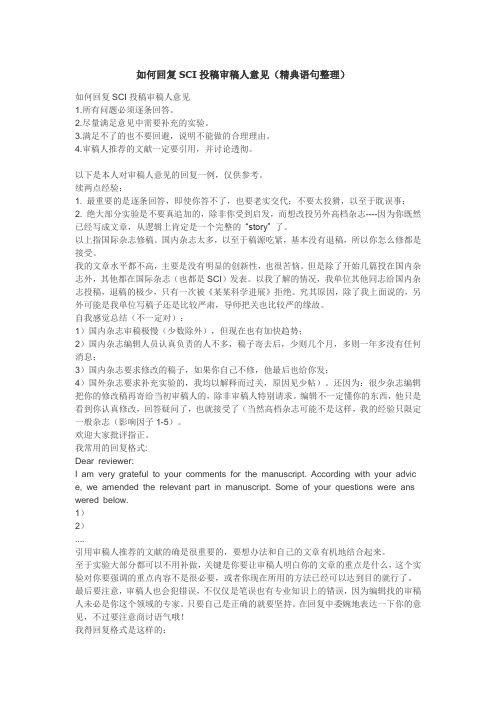
如何回复SCI投稿审稿人意见(精典语句整理)如何回复SCI投稿审稿人意见1.所有问题必须逐条回答。
2.尽量满足意见中需要补充的实验。
3.满足不了的也不要回避,说明不能做的合理理由。
4.审稿人推荐的文献一定要引用,并讨论透彻。
以下是本人对审稿人意见的回复一例,仅供参考。
续两点经验:1. 最重要的是逐条回答,即使你答不了,也要老实交代;不要太狡猾,以至于耽误事;2. 绝大部分实验是不要真追加的,除非你受到启发,而想改投另外高档杂志----因为你既然已经写成文章,从逻辑上肯定是一个完整的“story” 了。
以上指国际杂志修稿。
国内杂志太多,以至于稿源吃紧,基本没有退稿,所以你怎么修都是接受。
我的文章水平都不高,主要是没有明显的创新性,也很苦恼。
但是除了开始几篇投在国内杂志外,其他都在国际杂志(也都是SCI)发表。
以我了解的情况,我单位其他同志给国内杂志投稿,退稿的极少,只有一次被《某某科学进展》拒绝。
究其原因,除了我上面说的,另外可能是我单位写稿子还是比较严肃,导师把关也比较严的缘故。
自我感觉总结(不一定对):1)国内杂志审稿极慢(少数除外),但现在也有加快趋势;2)国内杂志编辑人员认真负责的人不多,稿子寄去后,少则几个月,多则一年多没有任何消息;3)国内杂志要求修改的稿子,如果你自己不修,他最后也给你发;4)国外杂志要求补充实验的,我均以解释而过关,原因见少帖)。
还因为:很少杂志编辑把你的修改稿再寄给当初审稿人的,除非审稿人特别请求。
编辑不一定懂你的东西,他只是看到你认真修改,回答疑问了,也就接受了(当然高档杂志可能不是这样,我的经验只限定一般杂志(影响因子1-5)。
欢迎大家批评指正。
我常用的回复格式:Dear reviewer:I am very grateful to your comments for the manuscript. According with your advic e, we amended the relevant part in manuscript. Some of your questions were ans wered below.1)2)....引用审稿人推荐的文献的确是很重要的,要想办法和自己的文章有机地结合起来。
sci回复审稿人意见模板 -回复

sci回复审稿人意见模板-回复尊敬的审稿人,非常感谢您对我们的稿件进行审阅,并提供了宝贵的意见和建议。
根据您的反馈,我们对您提出的问题逐一进行了回答,以便进一步改善和完善我们的研究成果。
[问题1:请解释清楚为什么选择该研究主题。
]我们选择这个研究主题是因为它与当前科学社会的重要问题密切相关。
该主题基于对地球气候变化以及环境持续变化的探索。
目前,环境问题受到了人们越来越多的关注,其中气候变化是其中最紧迫且引人注目的问题之一。
我们希望通过研究来深入了解气候变化的根本原因以及与之相关的因素,以帮助我们更好地应对这个全球性的挑战。
[问题2:请更加详细地解释您所使用的研究方法并说明其可靠性。
]在我们的研究中,我们采用了XX方法来分析和解读数据。
这种方法已经被广泛用于类似的研究,并已被科学界公认为有效和可靠的分析工具。
我们通过仔细收集和整理相关数据,并运用适当的统计方法来得出结论。
此外,我们还进行了多次重复实验,以增加结果的可靠性和重复性。
在数据分析方面,我们采用了严格的统计学方法来检验结果的显著性和可信度。
总体来说,我们相信我们所使用的研究方法是可靠的,并能够有效地支持我们的研究结论。
[问题3:请进一步讨论您的研究结果对该领域的意义和影响。
]我们的研究结果对于该领域具有重要的意义和影响。
首先,我们的结果可以帮助科学家和政策制定者更好地了解气候变化的机理和动力学过程。
这种理解是制定有效的气候变化应对策略所必需的。
其次,我们的结果还可以为相关领域的进一步研究提供有价值的参考和基础。
我们的发现可能有助于揭示与气候变化相关的其他未知因素,并为深入研究提供新的思路和方向。
最后,我们的研究结果还对公众有重要意义,因为它可以提高人们对气候变化问题的认识,并推动人们采取积极的环保行动来减轻其影响。
[问题4:请回答如何应对审稿人提出的其他一些具体问题和建议。
]根据您提供的其他建议,我们将按照以下方式来应对:a. 针对您提出的统计方法方面的疑问,我们将进一步详细描述我们所采用的方法,并解释其适用性和优势。
针对审稿人意见的逐条回复
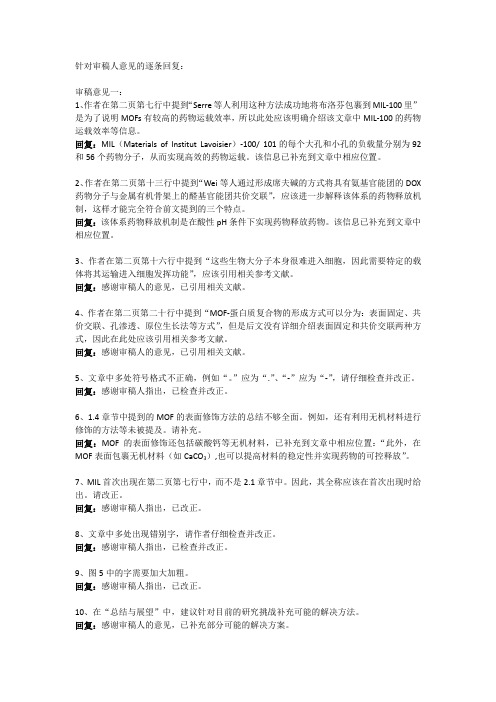
针对审稿人意见的逐条回复:审稿意见一:1、作者在第二页第七行中提到“Serre等人利用这种方法成功地将布洛芬包裹到MIL-100里”是为了说明MOFs有较高的药物运载效率,所以此处应该明确介绍该文章中MIL-100的药物运载效率等信息。
回复:MIL(Materials of Institut Lavoisier)-100/ 101的每个大孔和小孔的负载量分别为92和56个药物分子,从而实现高效的药物运载。
该信息已补充到文章中相应位置。
2、作者在第二页第十三行中提到“Wei等人通过形成席夫碱的方式将具有氨基官能团的DOX 药物分子与金属有机骨架上的醛基官能团共价交联”,应该进一步解释该体系的药物释放机制,这样才能完全符合前文提到的三个特点。
回复:该体系药物释放机制是在酸性pH条件下实现药物释放药物。
该信息已补充到文章中相应位置。
3、作者在第二页第十六行中提到“这些生物大分子本身很难进入细胞,因此需要特定的载体将其运输进入细胞发挥功能”,应该引用相关参考文献。
回复:感谢审稿人的意见,已引用相关文献。
4、作者在第二页第二十行中提到“MOF-蛋白质复合物的形成方式可以分为:表面固定、共价交联、孔渗透、原位生长法等方式”,但是后文没有详细介绍表面固定和共价交联两种方式,因此在此处应该引用相关参考文献。
回复:感谢审稿人的意见,已引用相关文献。
5、文章中多处符号格式不正确,例如“。
”应为“.”、“-”应为“-”,请仔细检查并改正。
回复:感谢审稿人指出,已检查并改正。
6、1.4章节中提到的MOF的表面修饰方法的总结不够全面。
例如,还有利用无机材料进行修饰的方法等未被提及。
请补充。
回复:MOF的表面修饰还包括碳酸钙等无机材料,已补充到文章中相应位置:“此外,在MOF表面包裹无机材料(如CaCO3),也可以提高材料的稳定性并实现药物的可控释放”。
7、MIL首次出现在第二页第七行中,而不是2.1章节中。
因此,其全称应该在首次出现时给出。
mdpi回复审稿人模板
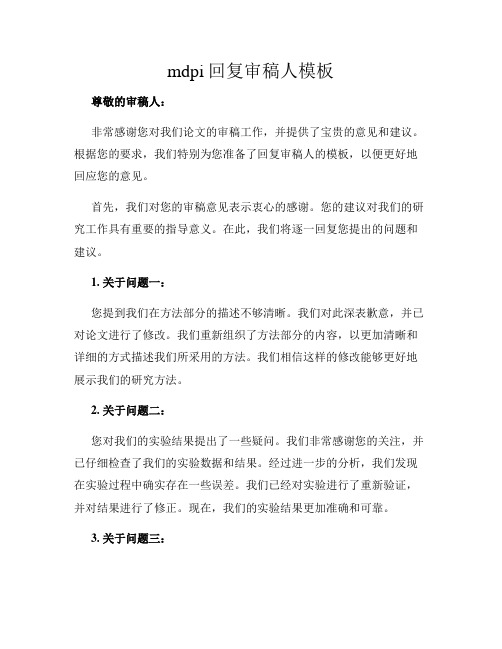
mdpi回复审稿人模板尊敬的审稿人:非常感谢您对我们论文的审稿工作,并提供了宝贵的意见和建议。
根据您的要求,我们特别为您准备了回复审稿人的模板,以便更好地回应您的意见。
首先,我们对您的审稿意见表示衷心的感谢。
您的建议对我们的研究工作具有重要的指导意义。
在此,我们将逐一回复您提出的问题和建议。
1. 关于问题一:您提到我们在方法部分的描述不够清晰。
我们对此深表歉意,并已对论文进行了修改。
我们重新组织了方法部分的内容,以更加清晰和详细的方式描述我们所采用的方法。
我们相信这样的修改能够更好地展示我们的研究方法。
2. 关于问题二:您对我们的实验结果提出了一些疑问。
我们非常感谢您的关注,并已仔细检查了我们的实验数据和结果。
经过进一步的分析,我们发现在实验过程中确实存在一些误差。
我们已经对实验进行了重新验证,并对结果进行了修正。
现在,我们的实验结果更加准确和可靠。
3. 关于问题三:您对我们的讨论部分提出了一些建议。
我们非常感谢您的建议,并已对讨论部分进行了修改。
我们重新组织了讨论的结构,并加入了更多的分析和解释,以更好地回答研究问题。
我们相信这样的修改能够使我们的讨论更加深入和有说服力。
4. 关于问题四:您对我们的引用格式提出了一些要求。
我们非常重视您的意见,并已对引用格式进行了仔细检查和修改。
我们确保所有的引用都符合学术规范,并在文中提供了正确的引用信息。
我们对此前的疏忽表示歉意,并感谢您的指正。
最后,再次感谢您对我们论文的审稿工作,并提供了宝贵的意见和建议。
我们非常重视您的意见,并已根据您的建议对论文进行了修改。
我们相信这样的修改能够使我们的论文更加完善和优秀。
如果您还有其他问题或建议,我们将非常乐意听取并进行相应的修改。
再次感谢您的辛勤工作和宝贵意见!祝好!作者。
审稿意见怎么回复整理
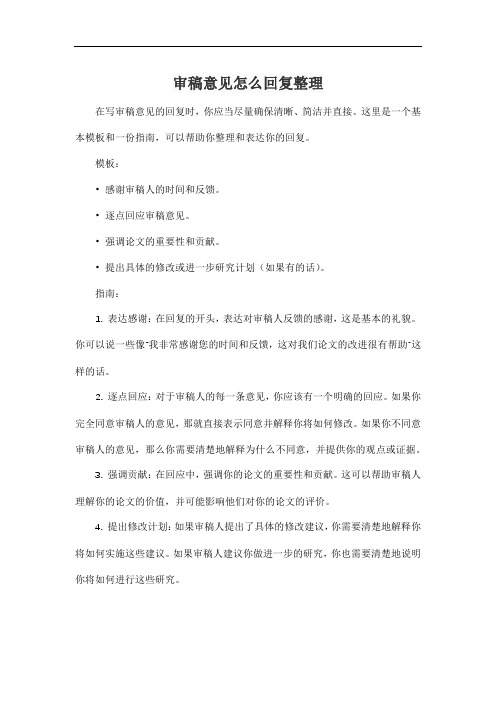
审稿意见怎么回复整理
在写审稿意见的回复时,你应当尽量确保清晰、简洁并直接。
这里是一个基本模板和一份指南,可以帮助你整理和表达你的回复。
模板:
•感谢审稿人的时间和反馈。
•逐点回应审稿意见。
•强调论文的重要性和贡献。
•提出具体的修改或进一步研究计划(如果有的话)。
指南:
1. 表达感谢:在回复的开头,表达对审稿人反馈的感谢,这是基本的礼貌。
你可以说一些像“我非常感谢您的时间和反馈,这对我们论文的改进很有帮助”这样的话。
2. 逐点回应:对于审稿人的每一条意见,你应该有一个明确的回应。
如果你完全同意审稿人的意见,那就直接表示同意并解释你将如何修改。
如果你不同意审稿人的意见,那么你需要清楚地解释为什么不同意,并提供你的观点或证据。
3. 强调贡献:在回应中,强调你的论文的重要性和贡献。
这可以帮助审稿人理解你的论文的价值,并可能影响他们对你的论文的评价。
4. 提出修改计划:如果审稿人提出了具体的修改建议,你需要清楚地解释你将如何实施这些建议。
如果审稿人建议你做进一步的研究,你也需要清楚地说明你将如何进行这些研究。
5. 避免争论:尽管你需要对你的论文的贡献和价值进行辩护,但你也需要避免与审稿人进行争论。
你的目标是让审稿人理解你的观点,而不是说服他们改变他们的观点。
6. 清晰简洁:你的回复应该清晰、简洁并直接。
避免使用复杂的语言或长句,尽量让你的回复容易理解。
记住,审稿人的反馈是宝贵的资源,他们帮助你提高你的论文的质量。
你应该尊重并认真考虑他们的反馈。
(完整版)回复审稿人意见模板

如何回复SCI投稿审稿人意见(精典语句整理)如何回复SCI投稿审稿人意见1.所有问题必须逐条回答。
2.尽量满足意见中需要补充的实验。
3.满足不了的也不要回避,说明不能做的合理理由。
4.审稿人推荐的文献一定要引用,并讨论透彻。
以下是本人对审稿人意见的回复一例,仅供参考。
续两点经验:1. 最重要的是逐条回答,即使你答不了,也要老实交代;不要太狡猾,以至于耽误事;2. 绝大部分实验是不要真追加的,除非你受到启发,而想改投另外高档杂志----因为你既然已经写成文章,从逻辑上肯定是一个完整的“story” 了。
以上指国际杂志修稿。
国内杂志太多,以至于稿源吃紧,基本没有退稿,所以你怎么修都是接受。
我的文章水平都不高,主要是没有明显的创新性,也很苦恼。
但是除了开始几篇投在国内杂志外,其他都在国际杂志(也都是SCI)发表。
以我了解的情况,我单位其他同志给国内杂志投稿,退稿的极少,只有一次被《某某科学进展》拒绝。
究其原因,除了我上面说的,另外可能是我单位写稿子还是比较严肃,导师把关也比较严的缘故。
自我感觉总结(不一定对):1)国内杂志审稿极慢(少数除外),但现在也有加快趋势;2)国内杂志编辑人员认真负责的人不多,稿子寄去后,少则几个月,多则一年多没有任何消息;3)国内杂志要求修改的稿子,如果你自己不修,他最后也给你发;4)国外杂志要求补充实验的,我均以解释而过关,原因见少帖)。
还因为:很少杂志编辑把你的修改稿再寄给当初审稿人的,除非审稿人特别请求。
编辑不一定懂你的东西,他只是看到你认真修改,回答疑问了,也就接受了(当然高档杂志可能不是这样,我的经验只限定一般杂志(影响因子1-5)。
欢迎大家批评指正。
我常用的回复格式:Dear reviewer:I am very grateful to your comments for the manuscript. According with your advice, we amended the relevant part in manuscript. Some of your questions were answered below.1)....引用审稿人推荐的文献的确是很重要的,要想办法和自己的文章有机地结合起来。
如何回复SCI投稿审稿人意见

如何回复SCI投稿审稿人意见(精典语句整理)如何回复SCI投稿审稿人意见1.所有问题必须逐条回答。
2.尽量满足意见中需要补充的实验。
3.满足不了的也不要回避,说明不能做的合理理由。
4.审稿人推荐的文献一定要引用,并讨论透彻。
以下是本人对审稿人意见的回复一例,仅供参考。
续两点经验:1. 最重要的是逐条回答,即使你答不了,也要老实交代;不要太狡猾,以至于耽误事;2. 绝大部分实验是不要真追加的,除非你受到启发,而想改投另外高档杂志----因为你既然已经写成文章,从逻辑上肯定是一个完整的“story” 了。
以上指国际杂志修稿。
国内杂志太多,以至于稿源吃紧,基本没有退稿,所以你怎么修都是接受。
我的文章水平都不高,主要是没有明显的创新性,也很苦恼。
但是除了开始几篇投在国内杂志外,其他都在国际杂志(也都是SCI)发表。
以我了解的情况,我单位其他同志给国内杂志投稿,退稿的极少,只有一次被《某某科学进展》拒绝。
究其原因,除了我上面说的,另外可能是我单位写稿子还是比较严肃,导师把关也比较严的缘故。
自我感觉总结(不一定对):1)国内杂志审稿极慢(少数除外),但现在也有加快趋势;2)国内杂志编辑人员认真负责的人不多,稿子寄去后,少则几个月,多则一年多没有任何消息;3)国内杂志要求修改的稿子,如果你自己不修,他最后也给你发;4)国外杂志要求补充实验的,我均以解释而过关,原因见少帖)。
还因为:很少杂志编辑把你的修改稿再寄给当初审稿人的,除非审稿人特别请求。
编辑不一定懂你的东西,他只是看到你认真修改,回答疑问了,也就接受了(当然高档杂志可能不是这样,我的经验只限定一般杂志(影响因子1-5)。
欢迎大家批评指正。
我常用的回复格式:Dear reviewer:I am very grateful to your comments for the manuscript. According with your adv ice, we amended the relevant part in manuscript. Some of your questions were an swered below.1)2)....引用审稿人推荐的文献的确是很重要的,要想办法和自己的文章有机地结合起来。
sci大修回复模板
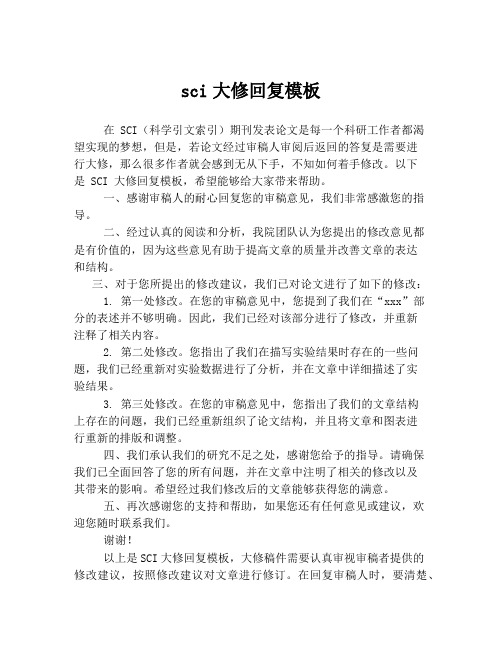
sci大修回复模板在 SCI(科学引文索引)期刊发表论文是每一个科研工作者都渴望实现的梦想,但是,若论文经过审稿人审阅后返回的答复是需要进行大修,那么很多作者就会感到无从下手,不知如何着手修改。
以下是 SCI 大修回复模板,希望能够给大家带来帮助。
一、感谢审稿人的耐心回复您的审稿意见,我们非常感激您的指导。
二、经过认真的阅读和分析,我院团队认为您提出的修改意见都是有价值的,因为这些意见有助于提高文章的质量并改善文章的表达和结构。
三、对于您所提出的修改建议,我们已对论文进行了如下的修改:1. 第一处修改。
在您的审稿意见中,您提到了我们在“xxx”部分的表述并不够明确。
因此,我们已经对该部分进行了修改,并重新注释了相关内容。
2. 第二处修改。
您指出了我们在描写实验结果时存在的一些问题,我们已经重新对实验数据进行了分析,并在文章中详细描述了实验结果。
3. 第三处修改。
在您的审稿意见中,您指出了我们的文章结构上存在的问题,我们已经重新组织了论文结构,并且将文章和图表进行重新的排版和调整。
四、我们承认我们的研究不足之处,感谢您给予的指导。
请确保我们已全面回答了您的所有问题,并在文章中注明了相关的修改以及其带来的影响。
希望经过我们修改后的文章能够获得您的满意。
五、再次感谢您的支持和帮助,如果您还有任何意见或建议,欢迎您随时联系我们。
谢谢!以上是SCI大修回复模板,大修稿件需要认真审视审稿者提供的修改建议,按照修改建议对文章进行修订。
在回复审稿人时,要清楚、明确地表明文章修改的内容、修改的原因,以及想要表达的意思,争取得到审稿人的认可与接受。
最后要表现出对审稿人的感激之情,尊重审稿人的劳动和建议,是大修回复模板的最后一部分。
SCI审稿意见回复模板

SCI审稿意见回复模板
尊敬的审稿人:
非常感谢您对本文的审阅和评论!我对您所给出的宝贵建议表示由衷
的谢意。
首先,我非常重视您对文章的全面审阅,并赞赏您为提高文章质量所
作出的积极贡献。
我们参照您的提议已对文章作了相应的修改和完善,具
体如下:
1.根据您的建议,我们对文章进行了结构的优化,使得内容清晰明了。
2.根据您的评论,我们对文章的引用资料进行了广泛的,增加了文章
的可信度和可操作性。
3.根据您的提议,我们加强了文章中的实证支持,并对受试者的结果
进行了相关的辩解分析,以提高结果的可信度。
4.根据您的建议,我们添加了文中缺少的历史背景和实证论据,从而
支持文中所提出的观点。
5.根据您的建议,我们对文章的语言进行了简化,使得内容易懂明了。
6.根据您的建议,我们对文章中的表格和图表进行了调整,使其与文
章内容完美结合。
最后,我们在修改文章后,还对文章进行了重新的检查,确保其完整
性和准确性。
再次感谢您对本次审稿工作的高度重视和重要贡献,我们也向您表示
衷心的感谢。
此致敬礼。
如何回复审稿人意见
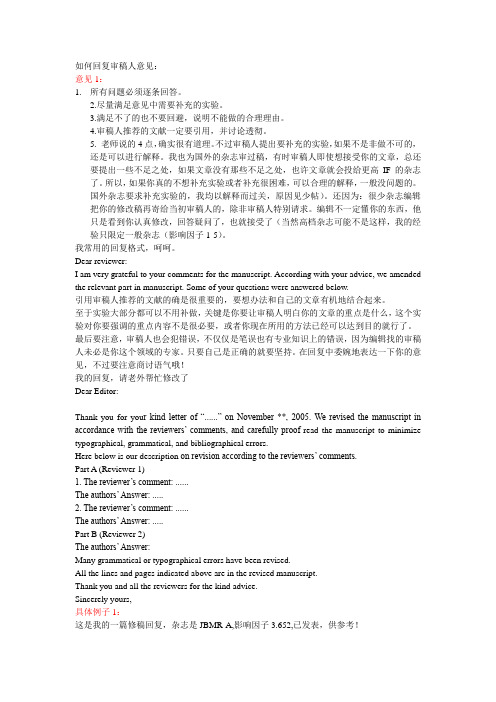
如何回复审稿人意见:意见1:1.所有问题必须逐条回答。
2.尽量满足意见中需要补充的实验。
3.满足不了的也不要回避,说明不能做的合理理由。
4.审稿人推荐的文献一定要引用,并讨论透彻。
5. 老师说的4点,确实很有道理。
不过审稿人提出要补充的实验,如果不是非做不可的,还是可以进行解释。
我也为国外的杂志审过稿,有时审稿人即使想接受你的文章,总还要提出一些不足之处,如果文章没有那些不足之处,也许文章就会投给更高IF的杂志了。
所以,如果你真的不想补充实验或者补充很困难,可以合理的解释,一般没问题的。
国外杂志要求补充实验的,我均以解释而过关,原因见少帖)。
还因为:很少杂志编辑把你的修改稿再寄给当初审稿人的,除非审稿人特别请求。
编辑不一定懂你的东西,他只是看到你认真修改,回答疑问了,也就接受了(当然高档杂志可能不是这样,我的经验只限定一般杂志(影响因子1-5)。
我常用的回复格式,呵呵。
Dear reviewer:I am very grateful to your comments for the manuscript. According with your advice, we amended the relevant part in manuscript. Some of your questions were answered below.引用审稿人推荐的文献的确是很重要的,要想办法和自己的文章有机地结合起来。
至于实验大部分都可以不用补做,关键是你要让审稿人明白你的文章的重点是什么,这个实验对你要强调的重点内容不是很必要,或者你现在所用的方法已经可以达到目的就行了。
最后要注意,审稿人也会犯错误,不仅仅是笔误也有专业知识上的错误,因为编辑找的审稿人未必是你这个领域的专家。
只要自己是正确的就要坚持。
在回复中委婉地表达一下你的意见,不过要注意商讨语气哦!我的回复,请老外帮忙修改了Dear Editor:Thank you for you r kind letter of “......” on November **, 2005. We revised the manuscript in accordance with the reviewers’ comments, and carefully proof-read the manuscript to minimize typographical, grammatical, and bibliographical errors.Here below is our description on revision according to the reviewers’ comments.Part A (Reviewer 1)1. The reviewer’s comment: ......The authors’ Answer: .....2. The reviewer’s comment: ......The authors’ Answer: .....Part B (Reviewer 2)The authors’ Answer:Many grammatical or typographical errors have been revised.All the lines and pages indicated above are in the revised manuscript.Thank you and all the reviewers for the kind advice.Sincerely yours,具体例子1:这是我的一篇修稿回复,杂志是JBMR-A,影响因子3.652,已发表,供参考!Reply to the comments on JBMR-A-05-0172Comment:Reference #10 is missing from the Introduction but used much later in the manuscript. Should these be in order used in manuscript?Reply:The missing reference has been added into the revised manuscript.Comment (continued):What is the sample size for all tests performed?Reply:The sample size for drug release and PCL degradation tests was 3.0×3.0 cm2, with a thickness of about 0.1mm and a weight of about 40mg. This dada have been added into the revised manuscript.Comment (continued):Figure 7. There is no scientific evidence presented in the TEM figure to convince this reviewer of sub-jets. This statement on Page 9 cannot be made without clear evidence during the jet formation/separation. Figure 7 is just a large fiber and small fiber fused together, no other conclusion than this can be made.Reply:Necessary change in the statements has been made in the revised manuscript as well as in the referred figure accordingly.Comment (continued):Table 3: Need standard deviation for all values reported not just for a select few.. Equation after Table 3 not necessary. Just reference method used.Reply:Done accordingly.Comment (continued):Page 11: "faster weight loss" What was the sample size? Where is the statistical analysis of this data? This reviewer does not see a significant difference in any of the data presented, thus weight loss would be considered equivalent.Reply:Although not too much difference was seen, the conclusion that “the GS/PCL membrane exhibited a relatively fa ster weight loss compared with the RT/PCL membrane” was indeed applicable through “one-way analysis of variance (ANOV A)” analysis.Following the reviewer’s comment, a new sub-section has been added to the manuscript to address the statistical analysis for the data.Comment (continued):Page 12: What is the sample size for release data? Looks like results based on a sample size of one? Need stand deviations on the data presented in Figure 11.Why wasn't release performed and compared for all electrospun conditions investigated otherwise?Reply:Three repeated tests were performed for each set of measurements and the resulting data were averaged. As stated in the revised manuscript, each sample had a square area of 3cm2 with a slightly different thickness. 3Standard deviations have been added to the data shown in Fig. 11.The present manuscript aimed to show that medical drugs can be encapsulated in ultrafine fibers through a co-axial electrospinning process. The drug release data intended to show that the encapsulation was successful. We did not consider any specific application in this preliminary paper, and in fact the two drugs were just chosen as model illustration. As such, there seemed not necessary to perform release experiments for all of the membranes electrospun with different conditions (i.e. the core concentrations)Comment (continued):Table 3: Yang's or Young's Modulus (page 10 says Young's).Reply:Corrected accordingly.Comment (continued):Figure 11: What is the % release, not just concentration. Why just this small sample of release data? Where is the release data for the other conditions?Reply:Unfortunately, we did not measure the amount of the shell material in obtaining the composite nanofibers. Namely, the flow rate of the shell solution during the electrospinning was not accurately controlled using an injecting pump. Hence the % release was not applicable.Please refer to the previous reply related to Page 12 and Figure 11 for the remaining comments. We acknowledge the reviewer’s comments and suggestions very much, which are valuable in improving the quality of our manuscript.具体例子2:Major comments:1. The authors need to strengthen their results by including MMPsecretion, and tran-matrigel migration by a positive controlprogenitor cell population i.e. enriched human CD34 cellsobtained from mobilized PBL, since this is a more clinicallyrelevant source of CD34 cells which has also been shown tosecrete both MMP-9 and MMP-2 (ref. 11). CD34 enriched cellsfrom steady state peripheral blood which also secrete MMPs arealso of interest.2. In fig 1C please specify which cell line representsMMP-negative cells. This needs to be clarified, as well as abetter explanation of the method of the protocol.3. The ELISA results are represented as "fold increase" comparedto control. Instead, we suggest that standards should be used andresults should be presented as absolute concentrations and onlythen can these results be compared to those of the zymography.4. When discussing the results, the authors should distinguishclearly between spontaneous migration vs chemotactic migration.Furthermore, the high spontaneous migration obtained with cordblood CD34 cells should be compared to mobilized PBL CD34enriched cells and discussed.5. The authors claim that the clonogenic assay was performed todetermine the optimum concentration for inhibition of MMPactivity by phenanthroline and anti MMP-9 mAb, however theyshould clarify that this assay can only determine the toxicity ofthe inhibitors and not their optimal inhibitory concentrations.Minor comments:1. There are many spelling and syntax errors, especially in theresults and discussion, which need correction.a. Of special importance, is the percent inhibition of migration,which is described as percent of migration. i.e. pg 7:"Migrationof CB CD34 was reduced to 73.3%?" Instead should read"Migration of CB CD34 was reduced by 73.3%?"b. The degree symbol needs to be added to the numbers inMaterials and methods.2. It would be preferable to combine figure 1A and B, in order toconfirm the reliability of fig. 1B by a positive control(HT1080).Answer to referee 1 comment:1. Mobilized peripheral blood is a more clinical source of CD34+ cells, so it is necessary to compare the MMP-9 secretion and trans-migration ability of CB CD34+ cells with that of mobilized PB CD34+ cells. However, we couldn't obtain enough mobilized PB to separate PB CD34+ cells and determine the MMP-9 secretion and migration ability, so we couldn’t complement the study on PB CD34+ cells in this paper. Results obtained by Janowska-Wieczorek et al found that mobilized CD34+ cells in peripheral blood express MMP-9. Furthermore, Domenech’s study showed that MMP-9 secretion is involved in G-CSF induced HPC mobilization. Their conclusions have been added in the discussion. In our present study, our central conclusion from our data is that freshly isolated CD34+ stem/progenitor cells obtained from CB produce MMP-9.2. MMP-9 negative cell used in fig 1C was Jurkat cell. In zymographic analysis, MMP-9 was notdetected in the medium conditioned by Jurkat cell. To exclude that the contaminating cells may play a role in the observed MMP-9 production, we screened the media conditioned by different proportion of CB mononuclear cells with MMP-9 negative cells by zymography. This result may be confusion. Actually, only by detecting the medium conditioned by 2X105 CB mononuclear cells (MNC)/ml (since the purities of CD34+ cell are more than 90%), it could exclude the MNC role. In the revised manuscript, we only detected MMP-9 activity and antigen level in the medium conditioned by 2X105 CB mononuclear cells (MNC)/ml. There is no MMP-9 secretion be detected in the medium conditioned by 2X105 CB MNC/ml. It excluded the possibility that the MMP-9 activity in CB CD34+ cells conditioned medium is due to the contamination by MNC.3.In this revised paper, we have detected the MMP-9 antigen levels by using commercial specific ELISA kits (R&D System, sensitivity, 0.156ng/ml). Recombinant MMP-9 from R&D System was used as a standard. The results are expressed in the absolute concentration. The absolute concentration result has been added in the paper. As shown in Fig2, MMP-9 levels were detectable in both CB CD34+ cell conditioned medium and BM CD34+ cell conditioned medium. However, MMP-9 level was significantly higher in CB CD34+ cell conditioned medium than in BM CD34+ cell conditioned medium (0.406±0.133ng/ml versus 0.195±0.023ng/ml). Although gelatinolytic activity was not detected in media conditioned by CD34+ cells from BM, sensitivity of ELISA favors the detection of MMP-9 antigen in the BM CD34+.4. In our study, to establish the direct link between MMP-9 and CB CD34+ cells migration, we only determined the role of MMP-9 in spontaneous migration of CB CD34+ cells, but not in chemotactic migration. Actually, regulation of hematopoietic stem cell migration, homing and anchorage of repopulation cells to the bone marrow involves a complex interplay between adhesion molecules, chemokines, cytokines and proteolytic enzymes. Results obtained by the groups of Voermans reveal that not only the spontaneous migration but also the SDF-1 induced migration of CB CD34+ cells is greatly increased in comparison to CD34+ cells from BM and peripheral blood.5. CD34+ cells we obtained in each cord blood sample were very limited. It is not enough to screen the inhibitors concentrations to select the optimal inhibitory concentrations. In the blocking experiments, based on the concentrations used by others and the manufacturer's recommendation, we then determined the inhibitors concentrations by excluding the toxicity of the inhibitors in that concentration, which was determined by clonogenic assay.Minor comments:1.The spelling and syntax errors have been checked and corrected.2.Since the results in figure 1A and B were obtained from two separated and parallel experiments, it is not fitness to combine two figures.下面把我平时总结的一些答复审稿人的策略和写回复信的格式和技巧跟大家交流一下。
论文回复意见

论文回复意见
第一,不论审稿人提了什么意见,你在回复的时候一定要说:谢谢您的建议,您的所有建议都非常的重要,它们对我的论文写作和科研工作都具有重要的指导意义!
第二,如果审稿人提的意见你暂时无法做到(比如,要你增加实验或改进实验等)。
那么,为了论文尽快发表,你必须拒绝这样的要求。
但是,你不要摆出一大堆理由来证明这个意见是不好实现的。
你应该说:“谢谢您的建议,它非常的重要,由于您的建议,我发现了我目前工作中的不足之处,我会在以后的工作中按照您的建议提高科研水平,取得更多成绩!”这样说,等于委婉的拒绝了评审意见,又让评审人觉得你很看重他的意见。
第三,如果审稿人的意见明显有问题,也不说能说审稿人的意见是错误的,可以他的意见发表任何的评论,只需要列出你的理由和证据就可以了,结尾也不要强调自己的观点是正确的。
一句话,就是凭证据说话。
第四,如果审稿人的评价比较傲慢,而且有失公平。
那么,不用客气,直接写信给编辑,痛批审稿人。
(我就遇到过这样的情况,痛批后反而被录用。
)
第五,在回复信的结尾最好写上再次谢谢您的建议,希望能够从您哪里学到更多的知识。
这句话最好用黑体,要显眼。
如何回复审稿人意见
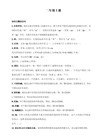
==================分页=======================
Responses to Reviewers
To Reviewer 1:
很多人都遇到过回复审稿人意见的时候。本人曾经因为回复审稿意见不合适而导致拒稿,相当的惨哪!!后来发现回复审稿意见时,除了写清修改内容外,还有一些话是必须要写的。对审稿人的意见提出不同的看法也应该讲究一定的技巧。由于这些话的英文都不难写,所以我直接写成中文表述,觉得有用的虫友自己翻译吧。
首先不论审稿人提了什么意见,你在回复的时候,第一句话一定要说:谢谢您的建议,您的所有建议都非常的重要,它们对我的论文写作和科研工作都具有重要的指导意义!!
如果审稿人的意见明显有问题。那么没办法了,你必须据理力争。但是,你一定不能说:审稿人先生,我认为你的意见是错的!你不必对他的意见发表任何的评论,只需要列出你的理由和证据就可以了,结尾也不要强调你的观点是正确的。简单说就是既不说你对,也不说我对,证据说话。
第五,如果审稿人的评价比较傲慢,而且有失公平。那么,不用客气,直接写信给编辑,痛批审稿人。(我就遇到过这样的情况,痛批后反而被录用。)
意见1:置疑文章的创新性,提出相似的工作已经被A和B做过。
Thank you for pointing this out. A and B’s research groups have done blablablabla. However, the focus of our work is on blablablabla, which is very different from A and B’s work, and this is also the major contribution of our work. We have added the following discussion on this issue in our revised manuscript, see LOA2.
回复审稿意见礼貌用语

回复审稿意见礼貌用语1. 尊敬的审稿专家,您的意见就像一阵及时雨,浇灭了我不少疑惑的小火苗,我定当全力以赴修改。
2. 审稿老师呀,您的眼光如同X光般犀利,指出的问题一针见血,我这就像勤劳的小蜜蜂一样去修正。
3. 亲爱的审稿人,您的建议简直是黑暗中的灯塔,照亮了我前行的路,我肯定马不停蹄地按照您说的改。
4. 尊敬的专家,您的评审意见好似孙悟空的金箍棒,一下子就把我的不足之处给打出来了,我会好好改进,绝不做那顽固的妖怪。
5. 审稿老师,您的眼光比老鹰还敏锐,发现的问题如同天上繁星一样清晰,我会一颗一颗把它们解决掉。
6. 亲爱的审稿专家,您的意见如同一记重锤,把我那些迷糊的想法都敲醒了,我这就重新打造一篇更好的文章。
7. 尊敬的审稿人,您的话就像魔法咒语,点出了文章的问题,我现在就像中了魔法的小木偶,乖乖听话去修改。
8. 审稿老师呀,您的评审如同照妖镜,让文章中的小瑕疵无处遁形,我得赶紧把这些小妖怪都收服了。
9. 亲爱的审稿专家,您的建议像超级英雄的信号弹,给我指明了修改的方向,我要像超级英雄去拯救世界一样去完善文章。
10. 尊敬的专家,您的意见像一把锋利的手术刀,精准地切割出文章的病灶,我这个小医生要赶紧进行治疗了。
11. 审稿老师,您指出的问题如同一串鞭炮,噼里啪啦地在我耳边炸响,我现在就清醒地去处理了。
12. 亲爱的审稿人,您的眼光似能看穿一切的透视眼,发现的问题让我惊叹,我会像建筑工人修补大厦漏洞一样去修订。
13. 尊敬的审稿专家,您的建议仿佛是打开宝藏的钥匙,让我知道如何让文章变得更有价值,我要赶紧挖掘这宝藏了。
14. 审稿老师呀,您的评审意见像一阵狂风,把我那些不扎实的论述都吹得摇摇欲坠,我得像加固房屋一样把它筑牢。
15. 亲爱的审稿专家,您的话就像紧箍咒一样,让我对文章的问题不敢忽视,我这就踏上修正的取经路。
16. 尊敬的审稿人,您的意见如同一把大火,把我文章中的一些杂草都烧光了,我要重新种上美丽的花朵。
sci审稿人回复模板

sci审稿人回复模板感谢您对我们的研究工作的关注和审稿意见。
我们已经仔细阅读了您的评论,并做出以下回复:1.首先,我们非常感谢您对我们的研究所做出的肯定和鼓励。
这对我们来说是一种巨大的动力。
2.对于您提出的关于方法的问题,我们已经认真考虑并进行了进一步的分析。
我们同意您的观点,目前我们正在重新评估并改进我们的方法。
3.关于数据分析的问题,我们确实意识到了在文章中可能存在的一些不足之处。
我们会重新进行数据分析,以更精确地支持我们的结论。
4.对于您提到的讨论部分缺乏深度的问题,我们感谢您的指出。
我们将在修订中进一步扩展和深化讨论部分,以更全面地解释我们的发现。
5.对于您对我们对比其他研究的不充分的批评,我们非常认同。
我们将在修订中增加更多的参考文献,以更全面地比较我们的研究与现有文献的联系。
6.您提到的实验设计和样本容量的问题已经引起了我们的注意。
我们将重新评估我们的实验设计,并增加样本容量以提高实验的可靠性和泛化性。
7.关于您关于讨论中对潜在机制的解释不足的批评,我们认识到了这一问题,并将在修订中增加和完善对潜在机制的解释。
8.您对我们的结果和结论的质疑提供了一个新的视角。
我们会对我们的结果进行重新分析,并考虑您的观点,以确保我们的结论更具说服力和可靠性。
9.针对您关于我们实验的外部效度的疑虑,我们会重新评估我们的实验方法,并增加更多的外部参照,以确保我们的研究结果更具泛化性。
10.对于您反馈的拼写和语法错误,我们会在修订中进行仔细的校对,以确保文章的语言表达更加正确和流畅。
11.感谢您的建议,我们确实考虑过进行进一步的控制变量。
我们将在修订中补充更详细的控制变量操作,以解决您的疑虑。
12.关于您观察到的样本偏倚,我们会在修订中详细讨论我们的样本招募过程,并考虑您的建议以改进我们的样本代表性。
13.对于您对我们的实证方法的质疑,我们会重新评估我们的数据收集和分析方法,并考虑您的建议以提高实证的可靠性和有效性。
Nature子刊实例—如何回复审稿人评审意见
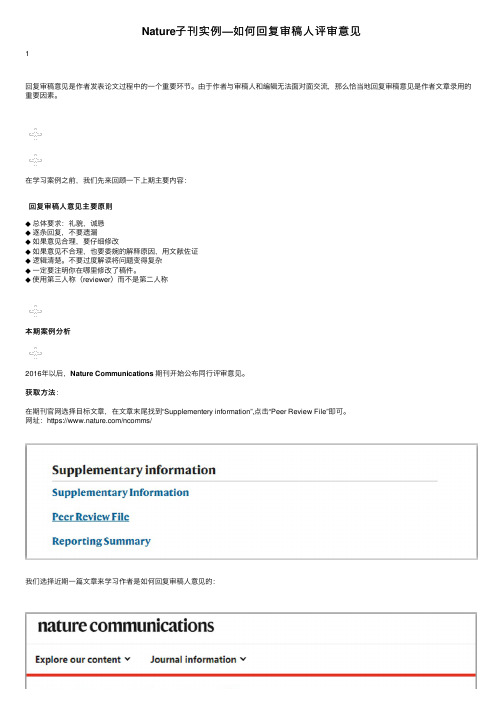
Nature⼦刊实例—如何回复审稿⼈评审意见1回复审稿意见是作者发表论⽂过程中的⼀个重要环节。
由于作者与审稿⼈和编辑⽆法⾯对⾯交流,那么恰当地回复审稿意见是作者⽂章录⽤的重要因素。
在学习案例之前,我们先来回顾⼀下上期主要内容:回复审稿⼈意见主要原则◆总体要求:礼貌,诚恳◆逐条回复,不要遗漏◆如果意见合理,要仔细修改◆如果意见不合理,也要委婉的解释原因,⽤⽂献佐证◆逻辑清楚。
不要过度解读将问题变得复杂◆⼀定要注明你在哪⾥修改了稿件。
◆使⽤第三⼈称(reviewer)⽽不是第⼆⼈称本期案例分析2016年以后,Nature Communications期刊开始公布同⾏评审意见。
获取⽅法:获取⽅法在期刊官⽹选择⽬标⽂章,在⽂章末尾找到“Supplementery information”,点击“Peer Review File”即可。
⽹址:https:///ncomms/我们选择近期⼀篇⽂章来学习作者是如何回复审稿⼈意见的:01回复信开头清楚的展⽰标题“Response to reviewers”,接下来⽤⼀段话感谢审稿⼈和编辑,并且简述⾃⼰对⽂章的改动。
这篇⽂章的作者写的⽐较简洁。
对于⼤多数⼈来说,写的充实⼀点会更能赢得编辑的好感。
例如,在Rare and common vertebrates span a wide spectrum of population trends这篇⽂章中的作者回复就很有参考价值:作者在标题中标明了⽂章编号,主要作者。
内容上,第⼀段感谢了编辑和审稿⼈,第⼆段描述了作者对⽂章的主要改动。
然后,逐条撰写对每位审稿⼈的主要回复内容:02负⾯意见回复“......综上所述,作者提供的信息声称......有点可疑,但不是⽆可争辩的。
如果把上⾯提到的⼀些问题弄清楚,⼿稿可能会更好。
这⼀条意见实际上在质疑作者的数据结果。
我们看看作者是如何回复的:回复(Response)我们同意审稿⼈的观点,即我们的研究中有⼏个发现是出乎意料的......(先同意专家看法)We agree with the reviewer that several of the findings in our study are unexpected, including......虽然⼤多数认为......但在⼀些研究中也发现了类似结果…并不削弱我们的结论......(引⽤前⼈⽂献,佐证⾃⼰的研究结果,语⽓委婉)Although most ......are shared......the fact that some......are seen only in......, Such ...... has been observed in other settings ...... and does not diminish the conclusion of x that......此外,参考审稿⼈关于......的观点。
ieeeaccess 回复审稿人修改意见

ieeeaccess 回复审稿人修改意见1.非常感谢您对我们提交的稿件进行审稿并提出修改意见。
2.根据您的建议,我们对稿件进行了细致的修订和修改。
3.我们已经认真考虑并采纳了您提出的修改建议。
4.感谢您指出其中的问题和不足之处,我们做出了必要的改进。
5.我们对您提供的指导非常感激,并在稿件中进行了相应的修改。
6.我们已经根据您的建议对论文结构进行了调整。
7.根据您的修改意见,我们重新组织了论文的论证逻辑。
8.在您的指导下,我们对论文中的实验部分进行了更详细的描述。
9.您的建议对提高我们的论文质量起到了至关重要的作用。
10.我们已经根据您的建议对引用的文献进行了更新和调整。
11.您的意见对我们来说具有很大的启示作用。
12.我们根据您的建议增加了论文中的实验结果图表。
13.我们已经充分考虑并根据您的修改意见重新论述了研究背景。
14.感谢您对我们的论文方法论和数据分析进行了深入的审查。
15.我们已经根据您的意见对论文中的研究目的和结果进行了进一步澄清。
16.您的修改意见对我们的研究方法和实验设计起到了很大的改进作用。
17.我们已经在您的建议下对论文中的技术术语进行了进一步说明。
18.我们根据您的指导对论文中的结论和讨论进行了全面修订。
19.您的修改建议对我们的研究框架和理论模型提升了更高的准确度。
20.我们已经根据您的指导对论文中的数据采集和分析过程进行了进一步细化。
21.您的审稿意见对我们的研究结论有着重要的指导意义。
22.感谢您对我们研究结果的准确性进行了严格的检查。
23.我们已经根据您的指导对论文中的图表和图像进行了进一步优化。
24.在您的建议下,我们对论文中的文字表达进行了更加精确的描述。
25.您的修改意见帮助我们充实了论文中的实证分析部分。
26.我们已经根据您的意见对论文中的文献综述进行了进一步扩展。
27.感谢您对我们的研究框架提出了关键的修正建议。
28.我们已经根据您的修改意见对论文中的案例研究进行了进一步分析和评估。
怎么回复审稿人意见

怎么回复审稿人意见
“怎么回复审稿人意见”是一个棘手的问题,在学术写作中,如何回复审稿人意见对于作者来说并不容易。
审稿意见可能会影响文章的发表,而作者在审稿中的回应则是起到关键作用的。
因此,回复审稿意见时要仔细、慎重。
首先,要仔细阅读审稿意见,弄清楚审稿人的要求,同时了解审稿人的大致态度,判断出审稿人是否真心希望文章发表成功。
之后要客观分析审稿意见,根据审稿人要求修改文章,在修改文章过程中,要注意保留文章原有的理念和结构,尽可能地回答审稿人的每一个问题。
其次,在回复审稿意见时要直接清楚地表达自己的观点,使审稿人能够清楚地了解作者的思想,避免歧义。
同时,要尊重审稿人的意见,把审稿人的建议作为一种有价值的反馈,从中吸取教训,改善文章,使文章更加完善。
另外,回复审稿意见时应当注意文字的选择,避免使用粗鲁、攻击性的语言,发挥多方协商的作用,在回复审稿人意见时尽量使用礼貌的语气,表达自己的意见,同时让审稿人明白作者的态度和意图,尽量保持友好的关系。
最后,在回复审稿人意见时,要谨记所有的审稿意见,要及时回答审稿人的每一个问题,不要拖延时间,尽
可能快地反馈审稿意见,以确保文章能够准确、及时地发表。
总之,如何回复审稿人意见对于作者来说并不容易,但也并非不可能。
回复审稿人意见时,应当仔细阅读审稿意见,客观分析审稿意见,直接清楚地表达自己的观点,尊重审稿人的意见,注意文字的选择,及时回答审稿人的每一个问题,以希望文章能够准确及时地发表。
- 1、下载文档前请自行甄别文档内容的完整性,平台不提供额外的编辑、内容补充、找答案等附加服务。
- 2、"仅部分预览"的文档,不可在线预览部分如存在完整性等问题,可反馈申请退款(可完整预览的文档不适用该条件!)。
- 3、如文档侵犯您的权益,请联系客服反馈,我们会尽快为您处理(人工客服工作时间:9:00-18:30)。
如何回复审稿人意见:意见1:所有问题必须逐条回答。
2.尽量满足意见中需要补充的实验。
3.满足不了的也不要回避,说明不能做的合理理由。
4.审稿人推荐的文献一定要引用,并讨论透彻。
5. 老师说的4点,确实很有道理。
不过审稿人提出要补充的实验,如果不是非做不可的,还是可以进行解释。
我也为国外的杂志审过稿,有时审稿人即使想接受你的文章,总还要提出一些不足之处,如果文章没有那些不足之处,也许文章就会投给更高IF的杂志了。
所以,如果你真的不想补充实验或者补充很困难,可以合理的解释,一般没问题的。
国外杂志要求补充实验的,我均以解释而过关,原因见少帖)。
还因为:很少杂志编辑把你的修改稿再寄给当初审稿人的,除非审稿人特别请求。
编辑不一定懂你的东西,他只是看到你认真修改,回答疑问了,也就接受了(当然高档杂志可能不是这样,我的经验只限定一般杂志(影响因子1-5)。
我常用的回复格式,呵呵。
Dear reviewer:I am very grateful to your comments for the manuscript. According with your advice, we amended the relevant part in manuscript. Some of your questions wereanswered below.引用审稿人推荐的文献的确是很重要的,要想办法和自己的文章有机地结合起来。
至于实验大部分都可以不用补做,关键是你要让审稿人明白你的文章的重点是什么,这个实验对你要强调的重点内容不是很必要,或者你现在所用的方法已经可以达到目的就行了。
最后要注意,审稿人也会犯错误,不仅仅是笔误也有专业知识上的错误,因为编辑找的审稿人未必是你这个领域的专家。
只要自己是正确的就要坚持。
在回复中委婉地表达一下你的意见,不过要注意商讨语气哦!我的回复,请老外帮忙修改了Dear Editor:Thank you for your kind letter of “......” on November **, 2005. We revised the manuscript in accordance with the reviewers’comments, and carefully proof-read the manuscript to minimize typographical, grammatical, and bibliographical errors.Here below is our description on revision according to the reviewers’ comments.Part A (Reviewer 1)1. The reviewer’s comment: ......The authors’ Answer: .....2. The reviewer’s comment: ......The authors’ Answer: .....Part B (Reviewer 2)The authors’ Answer:Many grammatical or typographical errors have been revised.All the lines and pages indicated above are in the revised manuscript.Thank you and all the reviewers for the kind advice. Sincerely yours,具体例子1:这是我的一篇修稿回复,杂志是JBMR-A,影响因子3.652,已发表,供参考!Reply to the comments on JBMR-A-05-0172Comment:Reference #10 is missing from the Introduction but used much later in the manuscript. Should these be in order used in manuscript?Reply:The missing reference has been added into the revisedmanuscript.Comment (continued):What is the sample size for all tests performed?Reply:The sample size for drug release and PCL degradation tests was 3.0×3.0 cm2, with a thickness of about 0.1mm and a weight of about 40mg. This dada have been added into the revised manuscript.Comment (continued):Figure 7. There is no scientific evidence presented in the TEM figure to convince this reviewer of sub-jets. This statement on Page 9 cannot be made without clear evidence during the jet formation/separation. Figure 7 is just a large fiber and small fiber fused together, no other conclusion than this can be made.Reply:Necessary change in the statements has been made in the revised manuscript as well as in the referredfigure accordingly.Comment (continued):Table 3: Need standard deviation for all values reported not just for a select few.. Equation after Table 3 not necessary. Just reference method used.Reply:Done accordingly.Comment (continued):Page 11: "faster weight loss" What was the sample size? Where is the statistical analysis of this data? This reviewer does not see a significant difference in any of the data presented, thus weight loss would be considered equivalent.Reply:Although not too much difference was seen, the conclusion that “the GS/PCL membrane exhibited a relatively faster weight loss compared with the RT/PCL membrane” was indeed applicable through “one-way analysis of variance (ANOVA)” analysis. Following the reviewer’s comment, a new sub-section has been added to the manuscript to address the statistical analysis for the data.Comment (continued):Page 12: What is the sample size for release data? Looks like results based on a sample size of one? Need stand deviations on the data presented in Figure 11.Why wasn't release performed and compared for all electrospun conditions investigated otherwise?Reply:Three repeated tests were performed for each set of measurements and the resulting data were averaged. As stated in the revised manuscript, each sample had a square area of 3cm2 with a slightly different thickness. 3Standard deviations have been added to the data shown in Fig. 11.The present manuscript aimed to show that medicaldrugs can be encapsulated in ultrafine fibers through a co-axial electrospinning process. The drug release data intended to show that the encapsulation was successful. We did not consider any specific application in this preliminary paper, and in fact the two drugs were just chosen as model illustration. As such, there seemed not necessary to perform release experiments for all of the membranes electrospun with different conditions (i.e. the core concentrations)Comment (continued):Table 3: Yang's or Young's Modulus (page 10 says Young's).Reply:Corrected accordingly.Comment (continued):Figure 11: What is the % release, not just concentration. Why just this small sample of release data? Where is the release data for the other conditions?Reply:Unfortunately, we did not measure the amount of the shell material in obtaining the composite nanofibers. Namely, the flow rate of the shell solution during the electrospinning was not accurately controlled using an injecting pump. Hence the % release was not applicable.Please refer to the previous reply related to Page 12 and Figure 11 for the remaining comments.We acknowledge the reviewer’s comments and suggestions very much, which are valuable in improving the quality of our manuscript.具体例子2:Major comments:1. The authors need to strengthen their results by including MMPsecretion, and tran-matrigel migration by a positive controlprogenitor cell population i.e. enriched human CD34 cellsobtained from mobilized PBL, since this is a moreclinicallyrelevant source of CD34 cells which has also been shown tosecrete both MMP-9 and MMP-2 (ref. 11). CD34 enriched cellsfrom steady state peripheral blood which also secrete MMPs arealso of interest.2. In fig 1C please specify which cell line represents MMP-negative cells. This needs to be clarified, as well as abetter explanation of the method of the protocol.3. The ELISA results are represented as "fold increase" comparedto control. Instead, we suggest that standards should be used andresults should be presented as absolute concentrations and onlythen can these results be compared to those of the zymography.4. When discussing the results, the authors should distinguishclearly between spontaneous migration vs chemotactic migration.Furthermore, the high spontaneous migration obtained with cordblood CD34 cells should be compared to mobilized PBL CD34enriched cells and discussed.5. The authors claim that the clonogenic assay was performed todetermine the optimum concentration for inhibition of MMPactivity by phenanthroline and anti MMP-9 mAb, however theyshould clarify that this assay can only determine the toxicity ofthe inhibitors and not their optimal inhibitory concentrations.Minor comments:1. There are many spelling and syntax errors, especially in theresults and discussion, which need correction.a. Of special importance, is the percent inhibition of migration,which is described as percent of migration. i.e. pg 7:"Migrationof CB CD34 was reduced to 73.3%?" Instead should read "Migration of CB CD34 was reduced by 73.3%?"b. The degree symbol needs to be added to the numbers inMaterials and methods.2. It would be preferable to combine figure 1A and B, in order toconfirm the reliability of fig. 1B by a positive control(HT1080).Answer to referee 1 comment:1. Mobilized peripheral blood is a more clinical source of CD34+ cells, so it is necessary to compare the MMP-9 secretion and trans-migration ability of CB CD34+ cells with that of mobilized PB CD34+ cells. However, we couldn't obtain enough mobilized PB toseparate PB CD34+ cells and determine the MMP-9 secretion and migration ability, so we couldn’t complement the study on PB CD34+ cells in this paper. Results obtained by Janowska-Wieczorek et al found that mobilized CD34+ cells in peripheral blood express MMP-9. Furthermore, Domenech’s study showed that MMP-9 secretion is involved in G-CSF induced HPC mobilization. Their conclusions have been added in the discussion. In our present study, our central conclusion from our data is that freshly isolated CD34+ stem/progenitor cells obtained from CB produce MMP-9.2. MMP-9 negative cell used in fig 1C was Jurkat cell. In zymographic analysis, MMP-9 was not detected in the medium conditioned by Jurkat cell. To exclude that the contaminating cells may play a role in the observed MMP-9 production, we screened the media conditioned by different proportion of CB mononuclear cells with MMP-9 negative cells by zymography. This result may be confusion. Actually, only by detecting the medium conditioned by 2X105 CB mononuclear cells(MNC)/ml (since the purities of CD34+ cell are more than 90%), it could exclude the MNC role. In the revised manuscript, we only detected MMP-9 activity and antigen level in the medium conditioned by 2X105 CB mononuclear cells (MNC)/ml. There is no MMP-9 secretion be detected in the medium conditioned by 2X105 CB MNC/ml. It excluded the possibility that the MMP-9 activity in CB CD34+ cells conditioned medium is due to the contamination by MNC.3.In this revised paper, we have detected the MMP-9 antigen levels by using commercial specific ELISA kits (R&D System, sensitivity, 0.156ng/ml). Recombinant MMP-9 from R&D System was used as a standard. The results are expressed in the absolute concentration. The absolute concentration result has been added in the paper. As shown in Fig2, MMP-9 levels were detectable in both CB CD34+ cell conditioned medium and BM CD34+ cell conditioned medium. However, MMP-9 level was significantly higher in CB CD34+ cell conditioned medium than in BM CD34+ cell conditioned medium (0.406±0.133ng/ml versus0.195±0.023ng/ml). Although gelatinolytic activity was not detected in media conditioned by CD34+ cells from BM, sensitivity of ELISA favors the detection of MMP-9 antigen in the BM CD34+.4. In our study, to establish the direct link between MMP-9 and CB CD34+ cells migration, we only determined the role of MMP-9 in spontaneous migration of CB CD34+ cells, but not in chemotactic migration. Actually, regulation of hematopoietic stem cell migration, homing and anchorage of repopulation cells to the bone marrow involves a complex interplay between adhesion molecules, chemokines, cytokines and proteolytic enzymes. Results obtained by the groups of Voermans reveal that not only the spontaneous migration but also the SDF-1 induced migration of CB CD34+ cells is greatly increased in comparison to CD34+ cells from BM and peripheral blood.5. CD34+ cells we obtained in each cord blood sample were very limited. It is not enough to screen the inhibitors concentrations to select the optimalinhibitory concentrations. In the blocking experiments, based on the concentrations used by others and the manufacturer's recommendation, we then determined the inhibitors concentrations by excluding the toxicity of the inhibitors in that concentration, which was determined by clonogenic assay.Minor comments:1.The spelling and syntax errors have been checked and corrected.2.Since the results in figure 1A and B were obtained from two separated and parallel experiments, it is not fitness to combine two figures.下面把我平时总结的一些答复审稿人的策略和写回复信的格式和技巧跟大家交流一下。
